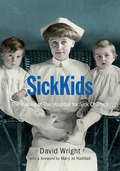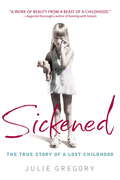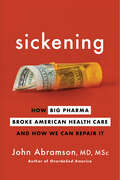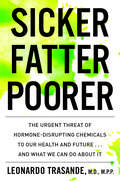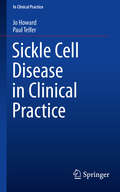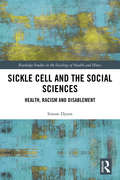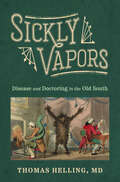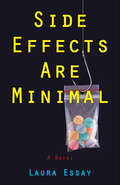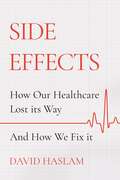- Table View
- List View
SickKids: The History of the Hospital for Sick Children
by David Wright Mary Jo Haddad The Hospital for Sick KidsToronto's Hospital for Sick Children is the most famous medical institution in Canada. In addition to being the largest pediatric centre in North America, it has earned an international reputation for clinical care and research that has influenced generations of health care practitioners across the country and around the world. In a very real sense, hospital staff have touched the lives of tens of thousands of children and their families. SickKids has an equally remarkable history - from its humble origins in rented houses in Victorian Toronto, the Hospital would flourish to become an influential paediatric institution, pioneering Pasteurization, the Iron Lung for Polio, Pablum, the Mustard Procedure for 'Blue Babies', and the discovery of the gene for Cystic Fibrosis. It would also be the site of two of most famous medical controversies in modern Canadian history -- the suspected murder of two dozen babies in the early 1980s and, more recently, the whistle-blowing controversy involving the research scientist, Nancy Olivieri. David Wright’s History of The Hospital for Sick Children chronicles this remarkable history of the SickKids, including its triumphs and tragedies, its discoveries and dead-ends. In doing so, Wright has crafted a compelling and accessible history of SickKids that anchors Toronto's children's hospital within the broader changes affecting Canadian society and medical practice over the last century.
Sickened: The True Story of a Lost Childhood
by Julie GregoryA young girl is perched on the cold chrome of yet another doctor's examining table, missing yet another day of school. Just twelve, she's tall, undernourished and weak. It's four o'clock, and she hasn't been allowed to eat anything all day - in fact she is often not allowed to eat much at all. She's terrified. Her mother, on the other hand, seems curiously excited. She's about to suggest open heart surgery on her child to "get to the bottom of this. " She checks her teeth for lipstick and, as the doctor enters, shoots the girl a warning glance. This child will not ruin her plans. Show them how sick you are - or else. From early childhood, Julie Gregory was continually X-rayed, medicated, starved and operated on-in the vain pursuit of an illness that was created in her mother's mind. Munchausen by proxy (or MBP) is the world's most hidden, misunderstood and lethal form of child abuse, in which the caretaker-almost always the mother-invents or induces symptoms in her child because she craves the attention of medical professionals. Julie Gregory is lucky to be alive. Most MBP children die. And Gregory not only survived, she escaped the powerful orbit of her mother's madness and rebuilt her identity as a vibrant, healthy young woman. SICKENED is a remarkable memoir that will leave an indelible mark on any one who reads it - Gregory's writing is superb and she interweaves this harrowing story with a fierce humour that somehow make this even more heartbreaking. This is not only a mesmerising piece of writing, but it's the first memoir by a survivor of Munchausen by proxy. Punctuated with Julie's actual medical records, it re-creates the bizarre cocoon of her family life along with the astonishing naiveté of medical professionals and social workers. It also exposes the twisted bonds of terror and love that roped Julie's family together-including the love that made a child willing to sacrifice herself to win her mother's happiness. The realisation that the sickness lay not in herself, but in her mother, would not come to Julie until adulthood. But when it did, it would strike like lightning. Through her painful metamorphosis, she discovered the courage to save her own life-and, ultimately, the life of the girl her mother had found to take her place.
Sickened: The True Story of a Lost Childhood
by Julie GregoryA young girl is perched on the cold chrome of yet another doctor’s examining table, missing yet another day of school. Just twelve, she’s tall, skinny, and weak. It’s four o’clock, and she hasn’t been allowed to eat anything all day. Her mother, on the other hand, seems curiously excited. She's about to suggest open-heart surgery on her child to "get to the bottom of this." She checks her teeth for lipstick and, as the doctor enters, shoots the girl a warning glance. This child will not ruin her plans. <P><P>Sickened <P><P>From early childhood, Julie Gregory was continually X-rayed, medicated, and operated on—in the vain pursuit of an illness that was created in her mother’s mind. <P><P>Munchausen by proxy (MBP) is the world’s most hidden and dangerous form of child abuse, in which the caretaker—almost always the mother—invents or induces symptoms in her child because she craves the attention of medical professionals. Many MBP children die, but Julie Gregory not only survived, she escaped the powerful orbit of her mother's madness and rebuilt her identity as a vibrant, healthy young woman. <P><P>Sickened is a remarkable memoir that speaks in an original and distinctive Midwestern voice, rising to indelible scenes in prose of scathing beauty and fierce humor. <P><P>Punctuated with Julie's actual medical records, it re-creates the bizarre cocoon of her family's isolated double-wide trailer, their wild shopping sprees and gun-waving confrontations, the astonishing naïveté of medical professionals and social workers. It also exposes the twisted bonds of terror and love that roped Julie's family together—including the love that made a child willing to sacrifice herself to win her mother's happiness. <P><P>The realization that the sickness lay in her mother, not in herself, would not come to Julie until adulthood. But when it did, it would strike like lightning. <P><P>Through her painful metamorphosis, she discovered the courage to save her own life—and, ultimately, the life of the girl her mother had found to replace her. Sickened takes us to new places in the human heart and spirit. It is an unforgettable story, unforgettably told.From the Hardcover edition.
Sickening: Anti-Black Racism and Health Disparities in the United States
by Anne PollockAn event-by-event look at how institutionalized racism harms the health of African Americans in the twenty-first century A crucial component of anti-Black racism is the unconscionable disparity in health outcomes between Black and white Americans. Sickening examines this institutionalized inequality through dramatic, concrete events from the past two decades, revealing how unequal living conditions and inadequate medical care have become routine. From the spike in chronic disease after Hurricane Katrina to the lack of protection for Black residents during the Flint water crisis—and even the life-threatening childbirth experience for tennis star Serena Williams—author Anne Pollock takes readers on a journey through the diversity of anti-Black racism operating in healthcare. She goes beneath the surface to deconstruct the structures that make these events possible, including mass incarceration, police brutality, and the hypervisibility of Black athletes&’ bodies. Ultimately, Sickening shows what these shocking events reveal about the everyday racialization of health in the United States.Concluding with a vital examination of racialized healthcare during the COVID pandemic and the Black Lives Matter rebellions of 2020, Sickening cuts through the mind-numbing statistics to vividly portray healthcare inequalities. In a gripping and passionate style, Pollock shows the devastating reality and consequences of systemic racism on the lives and health of Black Americans.
Sickening: How Big Pharma Broke American Health Care and How We Can Repair It
by John AbramsonThe inside story of how Big Pharma&’s relentless pursuit of ever-higher profits corrupts medical knowledge—misleading doctors, misdirecting American health care, and harming our health. The United States spends an excess $1.5 trillion annually on health care compared to other wealthy countries—yet the amount of time that Americans live in good health ranks a lowly 68th in the world. At the heart of the problem is Big Pharma, which funds most clinical trials and therefore controls the research agenda, withholds the real data from those trials as corporate secrets, and shapes most of the information relied upon by health care professionals. In this no-holds-barred exposé, Dr. John Abramson—one of the foremost experts on the drug industry&’s deceptive tactics—combines patient stories with what he learned during many years of serving as an expert in national drug litigation to reveal the tangled web of financial interests at the heart of the dysfunction in our health-care system. For example, one of pharma&’s best-kept secrets is that the peer reviewers charged with ensuring the accuracy and completeness of the clinical trial reports published in medical journals do not even have access to complete data and must rely on manufacturer-influenced summaries. Likewise for the experts who write the clinical practice guidelines that define our standards of care. The result of years of research and privileged access to the inner workings of the U.S. medical-industrial complex, Sickening shines a light on the dark underbelly of American health care—and presents a path toward genuine reform.
Sicker, Fatter, Poorer: The Urgent Threat of Hormone-Disrupting Chemicals to Our Health and Future . . . and What We Can Do About It
by Leonardo TrasandeA leading voice in public health policy and top environmental medicine scientist reveals the alarming truth about how hormone-disrupting chemicals are affecting our daily lives—and what we can do to protect ourselves and fight back. Lurking in our homes, hiding in our offices, and polluting the air we breathe is something sinister. Something we’ve turned a blind eye to for far too long. Dr. Leonardo Trasande, a pediatrician, professor, and world-renowned researcher, tells the story of how our everyday surroundings are making us sicker, fatter, and poorer. Dr. Trasande exposes the chemicals that disrupt our hormonal systems and damage our health in irreparable ways. He shows us where these chemicals hide—in our homes, our schools, at work, in our food, and countless other places we can’t control—as well as the workings of policy that protects the continued use of these chemicals in our lives. Drawing on extensive research and expertise, he outlines dramatic studies and emerging evidence about the rapid increases in neurodevelopmental, metabolic, reproductive, and immunological diseases directly related to the hundreds of thousands of chemicals that we are exposed to every day. Unfortunately, nowhere is safe. But, thanks to Dr. Trasande’s work on the topic, and his commitment to effecting change, this book can help. Through a blend of narrative, scientific detective work, and concrete information about the connections between chemicals and disease, he shows us what we can do to protect ourselves and our families in the short-term, and how we can help bring the change we deserve.
Sickle Cell Anemia
by Fernando Ferreira Costa Nicola ConranAlthough sickle cell anemia was the first molecular disease to be identified, its complex and fascinating pathophysiology is still not fully understood. A single mutation in the beta-globin gene incurs numerous molecular and cellular mechanisms that contribute to the plethora of symptoms associated with the disease. Our knowledge regarding sickle cell disease mechanisms, while still not complete, has broadened considerably over the last decades. Sickle Cell Anemia: From Basic Science to Clinical Practice aims to provide an update on our current understanding of the disease's pathophysiology and use this information as a basis to discuss its manifestations in childhood and adulthood. Current therapies and prospects for the development of new approaches for the management of the disease are also covered.
Sickle Cell Disease in Clinical Practice
by Jo Howard Paul TelferSickle Cell Disease is the most common genetic disease world wide and in the UK. It has marked geographical variation in its distribution in the UK, with a concentration in London and other major conurbations (Birmingham and Manchester). In these areas, specialist centres have become established offering expert, up to date care for both inpatients and out patients with Sickle Cell Disease. Although patient numbers are increasing outside these areas, the expertise of health professionals can be patchy. This book aims to provide a user friendly, accessible resource for areas with smaller numbers of patients, to allow them to provide equitable care with the larger well established centres. Sickle Cell Disease can be associated with acute life threatening complications, when clear, easily available advice is needed, and with chronic long term complications which may need liaison with other health professionals. Clear treatment protocols for all the common complications of sickle cell disease, are outlined here, with summaries of key evidence and references.
Sickle Cell Disease in Sub-Saharan Africa: Biomedical Perspectives
by Baba Inusa Kanayo Nwankwo Nkechikwu Azinge-Egbiri Bukola BolarinwaThis important collection provides an epidemiological perspective on the continuing scope of sickle cell disease (SCD) in sub-Saharan Africa, alongside the clinical attempts to provide comprehensive care in a resource-limited setting.The book moves from a clinical profile of SCD to screening for the disease and ongoing patient care. There are chapters on pain management, organ failure, infections and transfusions, as well as nutrition and neurocognitive complications. The book concludes with chapters on anti-sickness medication, cell transplantation and nursing care.The first in a two-volume set offering a multi-disciplinary perspective on SCD, this is a comprehensive resource that applies clinical knowledge to the practical challenges faced in sub-Saharan Africa. It will be important reading for medical students taking courses in haematology as well as those studying Public Health in sub-Saharan Africa. Practitioners in the region will also find it invaluable in developing their understanding of this pervasive disease.
Sickle Cell Disease in Sub-Saharan Africa: Public Health Perspectives
by Baba Inusa Kanayo Nwankwo Nkechikwu Azinge-Egbiri Bukola BolarinwaThis fascinating collection examines the socio-economic factors that impact the well-being of patients with sickle cell disease (SCD) in Sub-Saharan Africa and the critical importance of patient advocacy in the region.The book looks at a number of key issues, including the social determinants that influence the spread of the disease, the quality of life of children with SCD, the impact of stigma and the broader psychosocial burden of such a prevalent condition. There are also chapters on policy and Public Health management, including collaborations with non-governmental organisations (NGOs) and global partners.The second in a two-volume set offering a multi-disciplinary perspective on SCD, this insightful collection highlights many of the hidden issues faced across the region. It will be important reading for students of both Public Health and Medicine, as well as practitioners working for governments or NGOs.
Sickle Cell and the Social Sciences: Health, Racism and Disablement
by Simon M. DysonSickle cell disease (SCD) is a severe chronic illness and one of the world’s most common genetic conditions, with 400,000 children born annually with the disorder, mainly in Sub-Saharan Africa, India, Brazil, the Middle East and in diasporic African populations in North America and Europe. Biomedical treatments for SCD are increasingly available to the world’s affluent populations, while such medical care is available only in attenuated forms in Africa, India and to socio-economically disadvantaged groups in North America and Europe. Often a condition rendered invisible in policy terms because of its problematic association with politically marginalized groups, the social study of sickle cell has been neglected. This illuminating volume explores the challenges and possibilities for developing a social view of sickle cell, and for improving the quality of lives of those living with SCD. Tackling the controversial role of screening and genetics in SCD, the book offers a brief thematic history of approaches to the condition, queries the role of ethnicity and includes a discussion of how the social model of disability can be applied, as well as featuring chapters focusing on athletics, prisons and schools. Bringing together a wide range of original research conducted in the USA, the UK, Ghana and Nigeria, Sickle Cell and the Social Sciences is anchored in the discipline of sociology, but draws upon a diverse range of fields, including public health, anthropology, social policy and disability studies.
Sickly Vapors: Disease and Doctoring in the Old South
by Thomas HellingThe southern climate, with its heat, oppressive humidity, and stagnant marshland, accentuated disease and suffering for inhabitants of the Old South, from its early settling through the Civil War and Reconstruction. Vicious illnesses—from malaria and yellow fever to dysentery, cholera, typhoid fever, typhus, and smallpox—beleaguered those dwelling in the South and were blamed on the particular combination of air, earth, and water characteristic of those southern territories. As the rhetoric of southern sectionalism blossomed in the early nineteenth century, so did a growing feeling of southern distinctiveness in health issues. Sickly Vapors: Disease and Doctoring in the Old South is an examination of the unique circumstances of health and disease that shaped southern living and culture before, during, and after the Civil War. Through archival records, contemporary anecdotes, and scientific literature, Thomas Helling, MD, explores the intricacies of health and healthcare for an agrarian population that, by virtue of its location, was inordinately vulnerable to sicknesses and epidemics. With the influx of enslaved Africans, a new set of healthcare issues were introduced. Given the region’s peculiar climate, ethnic makeup, and customs, southern doctors adopted an attitude of distinctiveness themselves. As a result, southern medical progress became increasingly isolated from northern colleagues. The destructiveness of the Civil War finally provided the impetus for true integration with northern practices in the rapidly changing science of medicine and surgery. Yet, with the regeneration of a medical elitism in postbellum years, southern doctors clung to nostalgic notions of southern culture and southern medical distinctiveness. In this compelling volume, Helling explains how the predominant mindset of southern particularity guided regional interpretation of illness, therapeutic decisions, and medical education, foreboding a healthcare system embedded, still, with institutional racism.
Sickness And Health In America: Readings In The History Of Medicine And Public Health
by Judith Leavitt Ronald NumbersAn invaluable resource for students, scholars, and general readers, this highly regarded and widely used social history of medicine and public health in the United States is now available in a third edition. Extensively revised and updated, it includes twenty-one new essays; graphs illustrating the rise in deaths caused by HIV, homicide, and suicide; and a greatly expanded Guide to Further Reading. Entirely new sections on Sickness and Health, Early American Medicine, Therapeutics, the Art of Medicine, and Public Health and Personal Hygiene have been added, supplementing updated sections on the Science of Medicine, Education, the Allied Health Professions, Image and Income, Institutions, Race and Medicine, Epidemics, Public Health Reform, and Public Health and Medical Theory. An introductory essay and a series of historical photographs complement the articles.
Sickness Work: Personal Reflections Of A Sociologist
by Gerhard NijhofThis is the story of a professor of Medical Sociology, diagnosed with colon cancer. He undergoes the appropriate medical treatment. Passing through that trajectory, he realizes that things happen that he never read about in the professional literature. During his illness and rehabilitation he scribbles down notes about what is happening to him, what he is observing and what things do not tally with his knowledge of the sociological literature. This continuous connection of personal experience with academic literature is what makes this book such a powerful account of the ‘everyday’ life of a sick person. Recommended to teachers and students in the field of social health research; to everyone who works in health care, professionals as well as volunteers; and to men and women who themselves are experiencing a serious illness.
Sickness in Health: Bullying in Nursing and other Health Professions
by Brenda HappellThis book informs students and practitioners of the health professions about workplace bullying and how to recognise it. The health professions have among the highest rates of bullying of any occupational group. This book shines a light on bullying and its very real human consequences for health professionals. Statistics about bullying in health present a disturbing picture. However, they don't convey the human impact on people who only want to do good for others. The author begins by telling how her experiences spurred her to write this book and then introduces the champions, twelve health professionals who contributed their stories. The book starts with the champions' decision to become a health professional, and then describes their bullying experiences, the impact on almost every aspect of their lives and careers, and how they tried to resolve or deal with the bullying. Some were still dealing with bullying, and all felt they had been forever changed by their experiences.The stories show that bullying is much more than the actions of a few, it is deeply embedded in the culture of institutions responsible for providing quality health care. Better preparation for leadership positions and independent processes for reporting unacceptable behaviours and actions are two suggestions for tackling bullying and its consequences. This book shows the necessity to expose these appalling behaviours and their human costs in order to address workplace bullying and create a healthy and safe environment for everyone in healthcare. This volume is aimed at undergraduate and postgraduate students, and practitioners of nursing and other health professions, the general public and other stakeholders of health services. It will enhance their understanding of, ability to recognise, and strategies to cope with, workplace bullying.
Side Effects Are Minimal: A Novel
by Laura EssayWhen ambitious attorney Claire Hewitt is asked to represent the Satoris, one of Philadelphia’s most prominent families, in a lawsuit over the death of their daughter, she is thrust into an opioid nightmare with deadly impact—and not for the first time. Claire’s guilt for not saving her sister, Molly, has not subsided in the twenty years since Molly’s almost certainly opioid-related death. Now, with this new assignment, her guilt comes full circle. Who was really at fault in Molly’s death? And who is at fault now? What begins as a quest for truth becomes infinitely more complicated as Claire struggles to balance her desire for justice with the Satoris’ thirst for revenge. She knows she needs to expose the greed that transforms legal opioid production into illicit fabrications and the neglect that is the breaking point between physicians and their patients. But there are powerful people who will seemingly stop at nothing to prevent these truths from seeing the light of day, and she is sabotaged at every turn. Can she push past the obstacles in her way to build a winning case?Based on true events, Side Effects Are Minimal is about a corrupt pharmaceutical industry, the guilt of physicians prescribing the opioids that kill, and the pain experienced by families who’ve lost loved ones to an epidemic that has brought the United States to its knees.
Side Effects of Medical Cancer Therapy
by Mario A. DicatoThis book is a comprehensive handbook designed for quick reference by medical oncologists on the side-effects of cancer therapy drugs, including the chemotherapeutic drugs. Organised by organ system, it will list the toxicity, side-effects and measures of prevention pertaining to each type of drug used in cancer therapy. The most dangerous side-effects will be given priority so as to alert the reader to their importance.
Side Effects of Medical Cancer Therapy: Prevention and Treatment
by Mario A. Dicato Eric Van CutsemThis is the second edition of a well-received book that reflects the state of the art in cancer medical therapies and their side-effects, including immunotherapy and chemotherapeutic drugs. All chapters have been fully updated to include all the latest progress in drug discovery such as targeted therapies for each cancer type. From issues such as preservation of fertility to antiemetic therapy the book provides a very comprehensive overview of the field. The book includes a new chapter on immuno-oncology drugs. Organised by organ system, it lists the toxicity, side-effects and measures of prevention pertaining to each type of drug used in cancer therapy. The most dangerous side-effects are priority so as to alert the reader to their importance.Designed for quick reference in the clinical setting this book is primarily aimed at established medical oncologists but will also appeal to junior doctors, trainees, pharmacists and nurses.
Side Effects: A Prosecutor, a Whistleblower, and a Bestselling Antidepressant on Trial
by Alison BassAs the mental health reporter for the Boston Globe, Alison Bass's front-page reporting on conflicts of interest in medical research stunned readers, and her series on sexual misconduct among psychiatrists earned a Pulitzer Prize nomination. Now she turns her investigative skills to a controversial case that exposed the increased suicide rates among adolescents taking antidepressants such as Paxil, Prozac, and Zoloft.Side Effects tells the tale of a gutsy assistant attorney general who, along with an unlikely whistle-blower at an Ivy League university, uncovered evidence of deception behind one of the most successful drug campaigns in history. Paxil was the world's bestselling antidepressant in 2002. Pediatric prescriptions soared, even though there was no proof that the drug performed any better than sugar pills in treating children and adolescents, and the real risks the drugs posed were withheld from the public. The New York State Attorney General's office brought an unprecedented lawsuit against giant manufacturer GlaxoSmithKline, the maker of Paxil, for consumer fraud. The successful suit launched a tidal wave of protest that changed the way drugs are tested, sold, and marketed in this country. With meticulous research, Alison Bass shows us the underbelly of the pharmaceutical industry. She lays bare the unhealthy ties between the medical establishment, big pharma, and the FDA—relationships that place vulnerable children and adults at risk every day.
Side Effects: How Our Healthcare Lost Its Way – And How We Fix It
by David HaslamIn the shadow of the pandemic , how do we make a healthcare system that is affordable, effective and fair?With a single drug in the UK currently costing £ 340,000 per patient per year, or a gene therapy in the USA being costed at $1.2million, who should get such treatments, and how can we begin to afford them? Should we all be entitled to timely mental health therapy? How should we care for our old?As we grapple with the world's worst pandemic for a century, our minds are on our health more than ever. But what should we rightfully expect of doctors? In this original and thought-provoking book, Sir David Haslam explores what good healthcare should achieve and asks how we pay for it. Informed by patient stories and data from across the world - from US big pharma to Britain's NHS - this is an urgent and often moving examination of our most important asset: our health.
Sideline Management in Sports
by David Parker João Espregueira-Mendes Philippe Neyret Sérgio Rocha Piedade Mark R. HutchinsonThis book is a comprehensive reference guide for team physicians to manage common or rare clinical issues that may occur on the sidelines and field of play in recreational, professional or elite sports. Musculoskeletal injuries and health-related clinical issues that may occur on the field of play can directly impact the ability of athletes to safely participate in sport. Indeed, the ability to urgently respond to the myriad of health-related issues is critical during both sideline and event coverage. The variety of challenges may be more prevalent according to the type of sport, the athletes' physical condition, the field of play, the level of competition, as well as the environmental conditions. Initial assessment, proper investigation of athletes' clinical complaints and findings, followed by a well-practiced intervention protocol play an essential role in optimizing the outcome of each case. Written by an international team of experts, and published in partnership with ISAKOS, this book is an excellent source of knowledge for sports physicians, orthopedists and physiotherapists alike.
Siempre hay esperanza: Una historia personal en medio de un país fracturado
by Augusto Galan Sarmiento"En esencia, la historia de este libro es la historia de la transformación de un país en medio de desafíos extraordinarios". Alejandro Gaviria Augusto Galán Sarmiento ha estado involucrado en el sector de la salud en Colombia desde varias posiciones: fue cardiólogo de la Clínica Shaio por muchos años, ministro de Salud durante la presidencia de Ernesto Samper, embajador de Colombia ante la UNESCO, miembro de la Junta Directiva de la Fundación Saldarriaga Concha, dirigente gremial, paciente cardiovascular y padre de una hija en condición de discapacidad. Estas perspectivas le han permitido identificar la evolución del Sistema Nacional de Salud y también las mejoras en las que se debe seguir trabajando. En estas memorias personales y políticas el autor hace un recorrido por momentos determinantes de la historia nacional, como el asesinato de su hermano Luis Carlos Galán Sarmiento, la intrusión de la mafia en el Gobierno y la implementación de la ley 100 de 1993, que pretendía ampliar y mejorar la cobertura de salud en Colombia. Siempre hay esperanza es un testimonio honesto y crítico sobre el sistema de salud colombiano, pero es también la visión optimista de un país que avanza, a pesar de todos los obstáculos que se le han presentado.
Siete ensayos sobre la peste
by Carlos GamerroLa primera historia cultural de la peste: un recorrido erudito y reflexivo por epidemias y pandemias en la literatura y las artes, de la mano de Carlos Gamerro, uno de los novelistas y ensayistas más prestigiosos de la actualidad. Uno de los propósitos de estos ensayos sobre la peste es entendernos mejor: la vivencia de las epidemias y pandemias acompañó a la humanidad desde siempre; conocer su expresión en la literatura y las artes sirve para tener una imagen más acabada de nosotros mismos. El recorrido por la historia de las epidemias y pandemias en la literatura y las artes -desde la Ilíada hasta las películas de muertos vivos- que Carlos Gamerro propone en este libro interpela persistente nuestros tiempo y experiencia contemporáneos. Aquí se exploran orígenes e ideas, fantasías y decisiones políticas derivadas de la consideración de la peste como castigo divino, daño de brujas, guerra o conspiración. Al mismo tiempo se releen las condiciones de posibilidad del surgimiento del Diario del año de la peste de Daniel Defoe, la influencia de la costumbre de usar a la peste como metáfora de otras calamidades, como la guerra y la ocupación en La peste de Albert Camus, o los goces prohibidos que habilita en el Decamerón de Boccaccio, Muerte en Venecia o El amor en los tiempos del cólera. Fruto de una de las voces más potentes y originales en la novela y el ensayo argentinos contemporáneos, esta obra exquisita por lo erudita e iluminadora por lo reflexiva y original se erige en verdadera historia cultural de la peste, y en ese gesto deja ver su vocación de clásico.
Sight Unseen
by Georgina Kleege<P>This elegantly written book offers an unexpected and unprecidented accout of blindness and sight. Legally blind since the age of eleven, Georgina Kleege draws on her experiences to offer a detailed testimony of visual impairment - both her own view of the world and the world's view of the blind. "I hope to turn the reader's gaze outward, to say not only 'Here's what I see' but also "here's what you see,' to show what's both unique and universal," Kleege writes. <P>Kleege describes the negative social status of the blind, analyzes stereotypes of the blind hat have been perpetuated by movies, and discusses how blindness has been portrayed in literature. She vividly conveys the visual experience of someone with severely impaired sight and explains what she cannot (and how her inability to achieve eye contact - in a society that prizes that form of connection - has affected her). <P>Finally she tells of the various ways she reads, and the freedom she felt when she stopped concealing her blindness and acquired skills, such as reading braille, as part of a new blind identity.
Sight Unseen: An Exploration of Conscious and Unconscious Vision (Second Edition)
by David Milner Melvyn GoodaleIn this updated and extended edition of their book, Goodale and Milner explore one of the most extraordinary neurological cases of recent years-one that profoundly changed scientific views on the visual brain. Taking us on a journey into the unconscious brain, this book is a fascinating illustration of the power of the 'unconscious' mind.
